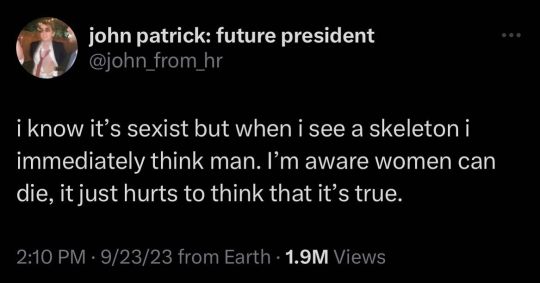just a place for me to scream into the void, mind your own business
Don't wanna be here? Send us removal request.
Text
radical feminism is a left-wing movement, but espousing some basic radfem ideas (ie, women are oppressed in patriarchal societies; prostitution is exploitative; gender ideology harms women's rights) doesn't automatically make you a leftist. you have to actually do the work and read left-wing theory (including theory not necessarily written by women; anticapitalist theory, antiracist theory, etc) to properly articulate the relationship between misogyny, racism and capitalism; to see how women's oppression is backed and supported by class society and racial oppression; to see how women of colour, working class women and third world women are uniquely oppressed in an imperialist, capitalist and patriarchal society. radical feminism isn't an identity or a label you can wear on and off, it's a movement you follow, it's principles you apply to yourself and how you see the world, it's radical actions you do in your day to day life. you have to actively work to be a leftist if you want to be a radical feminist. otherwise your liberation movement will only really cater to middle class, white and western women. working class women, woc and third world women will never be free if you don't also oppose imperialism, racism and capitalism. and that doesn't mean you have to include men in your feminism. you can oppose all these things while focusing on the women who're harmed by it
183 notes
·
View notes
Note
Best books you've read written by women? I hate reading stuff written by men lately...
Fiction(ish)
The Memory Police, Yoko Ogawa
A Ghost in the Throat, Doireann Ní Ghríofa
Paris, When It's Naked, Etel Adnan
Dept. of Speculation, Jenny Offill
My Sister, The Serial Killer, Oyinkan Braithwaite
Possession, A.S. Byatt
Cat's Eye, Margaret Atwood
The Tenderness of Wolves, Stef Penney
The Doll's Alphabet, Camilla Grudova
Her Body and Other Parties, Carmen Maria Machado
The People in the Room, Norah Lange
Água Viva, Clarice Lispector
Collected Stories, Clarice Lispector
The Empty Book, Josefina Vicens
Four Bare Legs in a Bed, Helen Simpson
The Thirteenth Tale, Diane Setterfield
A Tale for the Time Being, Ruth Ozeki
A Girl is a Half-Formed Thing, Eimear McBride
The God of Small Things, Arundhati Roy
Autobiography of Red, Anne Carson
White Teeth, Zadie Smith
Wuthering Heights, Emily Bronte
The Waves and Mrs Dalloway, Virginia Woolf
Non-Fiction:
Second-hand Time: The Last of the Soviets, Svetlana Alexievich
A Field Guide to Getting Lost, Rebecca Solnit
Bluets, Maggie Nelson
Living, Thinking, Looking, Siri Hustvedt
Feel Free: Essays, Zadie Smith
The Need for Roots, Simone Weil
Family Lexicon, Natalia Ginzburg
An Inventory of Losses, Judith Schalansky
Persepolis, Marjane Satrapi
Little Weirds, Jenny Slate
Braiding Sweetgrass, Robin Wall Kimmerer
Women Who Run with Wolves, Clarissa Pinkola Estés
Journal of a Solitude, May Sarton
Poetry:
The War Works Hard, Dunya Mikhail
Barefoot Souls and A Red Cherry on a White-Tiled Floor, Maram al-Masri
Tell Me and Wild Nights, Kim Addonizio
What the Living Do, Marie Howe
What We Carry, Dorianne Laux
Extracting the Stone of Madness, Alejandra Pizarnik
Poppies in Translation, Sujata Bhatt
The Neverfield: A Poem, Nathalie Handal
Women of the Fertile Crescent: An Anthology of Modern Poetry by Arab Women
View with a Grain of Sand, Wislawa Szymborska
The Black Unicorn, Audre Lorde
5K notes
·
View notes
Text
IOC Study on Transgender Athletes Severely Flawed
So, to a certain extent, the question of "should transwomen be able to compete female sports?" is an ideological question (i.e., "should identity supersede reality?").
That being said, there's a recent report [1], funded by the IOC, that is being used to "prove" that transwomen do not have a biological advantage over non-trans women. This report is severely flawed and does not actually lend support to the idea that transwomen have no biological advantage in sports over female people.
(I will mimic the language used in the report (e.g., using "ciswomen").)
Significant differences noted by the report that do NOT support transwomen's inclusion in women's sports:
Transwomen were substantially taller than ciswomen
Transwomen had more lean/fat-free mass than ciswomen
Transwomen had better lung function than ciswomen, as measured by forced vital capacity, forced expiratory volume in one second, and peak expiratory flow. (See the next section for a discussion on the ratio.)
Transwomen had greater hand grip strength (a proxy for overall strength measurement)
Transwomen had higher absolute peak power (lower extremity) compared to ciswomen. (See next section for a discussion on the relative measure.)
Transwomen had the same "absolute strength" as cismen
The data showing no significant difference between transwomen and ciswomen has substantial flaws:
The sample size was too small to reliably determine differences in bone mineral density
For lung function only the FEV1:FVC ratio was lower for transwomen, but the values are generally within the normal range for both groups. The impact of this difference is therefore questionable, as the transwomen have greater absolute values on each measurement and the ratio is not showing any abnormalities. In addition, the effect size (size of the difference) is much smaller than the effect size of the absolute differences described above. The conclusion here is simply that the participants do not have any obstructive respiratory diseases, and the transwomen have greater absolute lung function. (Although there are better tests for this.) There is also one outlier in the transwomen group that is likely driving this relationship in the ratio; unfortunately they do not perform the expected control analyses to demonstrate the retention of results without the outlier. [2]
The researchers decided to examine power in the lower extremities relative to lean/fat-free mass, which yielded a lower result for transwomen compared to ciswomen. However, this methodology make absolutely no sense. We have already established that transwomen have significantly greater lean/fat-free mass, and this paper is interested in determining equitably in sport performance. In general, sports aren't divided out by mass (and certainly not by lean mass), therefore we are interested in absolute differences, not in differences adjusted by some other factor. (Particularly not when that factor is established to be significantly different between transwomen and ciswomen!)
The same criticism applies to their analysis of cardiac function. But even more importantly, "the most crucial variable influencing VO2_max was not assessed in the present study" which is a significant oversight given the stated goals of this paper.
There are numerous other limitation and issues with this report:
This study is of "cross-sectional design, making it challenging to establish causation or examine if the performance of athletes changes as a result of undergoing GAHT"
"The athlete training intensity was self-reported. Therefore, the results may suffer from selection and recall bias." [emphasis mine] -> In other words, these results may be "comparing apples and oranges" with varying rates of fitness impacting the results.
"The athletes participating in the present study represented a variety of different sports, and this would have undoubtedly impacted the results of the study as different sports stress different training and sports modalities." [emphasis mine] -> This is a significant limitation, as comparing the strength of a ciswoman weight lifter to a transwomen distance runner (or vice versa) is meaningless. It's true that measures of fitness tend to correlate, but comparing across sport disciplines for highly competitive sports (where they are focusing on improving specific characteristics) distorts the results. (They explicitly note this: "Exercise type, intensity and duration all have an impact on physiological responses and overall laboratory performance metrics.")
"Social media recruitment leaves this study open to sample bias"
"The gender-affirming treatment of the transgender athletes was not controlled"
"The participants were not screened by a clinician before participation, and any medical conditions were self-reported"
The transwomen in this study all suppressed testosterone to ciswomen's levels and increased oestradiol above ciswomen's levels. This is a limitation because this degree of success in hormone suppression is uncommon, meaning that even these these poorly-supportive results are likely inapplicable to the majority of transwomen. [3]
There is a significant conflict of interest: this study was funded by the IOC after they had already changed the rules to remove the "hormone suppression" requirement [4]
All in all, this study is a classic case of researchers misrepresenting their data in the study's abstract. The data they actually collected shows that transwomen on hormone suppression maintain significant advantages over ciswomen. Further, the flaws in the study limit the applicability of their results.
---
In addition, there are other studies that contradict this result:
This review [3] discusses numerous sources describing "the inherent male physiological advantages that lead to superior athletic performance and then addresses how estrogen therapy fails to create a female-like physiology in the male"
This review [5] found "the performance gap between males and females becomes significant at puberty and often amounts to 10–50% depending on sport" and that "longitudinal studies examining the effects of testosterone suppression on muscle mass and strength in transgender women consistently show very modest changes, where the loss of lean body mass, muscle area and strength typically amounts to approximately 5% after 12 months of treatment. Thus, the muscular advantage enjoyed by transgender women is only minimally reduced when testosterone is suppressed."
This study [6] found that transwomen "generally maintained their strength level" during "gender-affirming therapy".
This study [7] found that all physical advantages were present after one year and that some are retained even after years on hormone suppression. They also specifically hypothesized that "gender dysphoria could stimulate the opposite behaviour [differences in exercise habits] in transwomen, decreasing push-up performance and explaining why transwomen performed fewer push-ups than [cismen] prior to starting oestrogen." This motivation difference likely won't apply to elite athletes, which further supports the idea that transwomen athletes should not be competing with female athletes.
As this position statement [8] indicates we know that there are substantial differences in athletic performance for male and female people.* However, there is little high-quality, definitive evidence concerning the effects of hormone suppression/replacement on people's athletic performance. The current state of evidence suggests that hormone suppression/replacement fails to bridge the physiological gap between male and female people, but we need further higher-quality evidence to definitively prove this.
(That being said, the burden of proof here is on the people attempting to initiate a change; that is equitably between transwomen and female people should be (have been) established prior to eliminating biological sex-separation.)
*Before anyone jumps on this: this is not a moral difference. There is absolutely no reason why running faster or lifting heavier things would make someone "better". The biological difference in performance exists, but it does not in anyway suggest superiority of men over women. Beyond that, it is unsurprising that men outperform women on traditional sports given that sports were designed by and for men. In sports that cater to women's physiological advantages (e.g., endurance, flexibility), women outperform men. [9]
---
So, given all this, what would we actually need to make determine transwomen's relative advantage over female people?
The "perfect" study would involve (at least) these elements:
Random selection from the desired population(s) of transwomen (e.g., top-ranked athletes in a specific sport, non-athletic, etc.) with matched (for population) non-trans female and non-trans male controls
Observation (not self-report) of activity level prior to, during, and following a standardized treatment (hormone suppression/replacement) initiation
Continual measurement of various physical and athletic performance, preferably with a range of laboratory (e.g., spirometry, body measurements) and naturalistic (e.g., actual sports competitions) tasks along with monitoring the treatment and clinical/health issues in all participants (again, not via self-report)
Large enough sample sizes to allow for sufficiently powered tests of all groups/differences of interest
A double-blinded assessment approach (or "placebo" controlled) such that both the researcher assessing the participants and the participants do not know what is being evaluated until the study is complete. For example, you may tell one half the transwomen participants that you are tracking the long term health effects of the intervention (hormone therapy), while you tell the other half that you are assessing differences in athletic performance as a result of the intervention. This will allow for the evaluation of demand characteristics like the ones impacting [7].
There are likely even more factors I have not currently thought of. Of course, completing the "perfect" study would likely be almost impossible. It would certainly be impossible to do for every population of interest (e.g., Olympic weight-lifters, adolescent track and field athletes, sedentary office workers) at the same time.
That being said, a study that fails to include all of these factors (particularly the blinded approach, matching of control participants, and sample size) is not going to meet the standard of evidence needed to make decisions of this magnitude (i.e., choosing to change the priority from biological categorization to ideological categorization). In reality, we would likely need many studies that individually evaluate each group of interest (e.g., transwomen olympic-level weight-lifters vs female olympic-level weight-lifters), each applying as many of the ideal study characteristics as possible.
In conclusion, the IOC has failed to perform their stated duty to regulate and ensure fair competition in sports. There is no current evidence suggesting that transwomen have lost their male-advantage in sports, much less any evidence suggesting they are at a disadvantage.
References below the cut:
Hamilton, B., Brown, A., Montagner-Moraes, S., Comeras-Chueca, C., Bush, P. G., Guppy, F. M., & Pitsiladis, Y. P. (2024). Strength, power and aerobic capacity of transgender athletes: a cross-sectional study. British Journal of Sports Medicine, 58(11), 586-597.
Al-Ashkar, F., Mehra, R., & Mazzone, P. J. (2003). Interpreting pulmonary function tests: recognize the pattern, and the diagnosis will follow. Cleveland Clinic journal of medicine, 70(10), 866-881.
Heather, A. K. (2022). Transwoman elite athletes: their extra percentage relative to female physiology. International Journal of Environmental Research and Public Health, 19(15), 9103.
“International Olympic Committee Issues New Guidelines on Transgender Athletes.” NBC News, 3 Jan. 2024, https://www.nbcnews.com/nbc-out/out-news/international-olympic-committee-issues-new-guidelines-transgender-athl-rcna5775.
Hilton, E. N., & Lundberg, T. R. (2021). Transgender women in the female category of sport: perspectives on testosterone suppression and performance advantage. Sports Medicine, 51, 199-214.
Wiik, A., Lundberg, T. R., Rullman, E., Andersson, D. P., Holmberg, M., Mandić, M., ... & Gustafsson, T. (2020). Muscle strength, size, and composition following 12 months of gender-affirming treatment in transgender individuals. The Journal of Clinical Endocrinology & Metabolism, 105(3), e805-e813.
Roberts, T. A., Smalley, J., & Ahrendt, D. (2021). Effect of gender affirming hormones on athletic performance in transwomen and transmen: implications for sporting organisations and legislators. British journal of sports medicine, 55(11), 577-583.
Pitsiladis, Yannis MMedSci, PhD, FACSM; Harper, Joanna MS; Betancurt, Jonathan Ospina; Martinez-Patino, Maria-Jose; Parisi, Attilio MD; Wang, Guan; Pigozzi, Fabio MD, PhD. Beyond Fairness: The Biology of Inclusion for Transgender and Intersex Athletes. Current Sports Medicine Reports 15(6):p 386-388, 11/12 2016. | DOI: 10.1249/JSR.0000000000000314
Ro, Christine. The sports where women outperform men. (2024). From https://www.bbc.com/future/article/20240731-the-sports-where-women-outperform-men
91 notes
·
View notes
Text
on the “its acceptable for women to wear men’s clothes but not men to wear women’s clothes” thing- its always forgotten that women and girls have been fighting in small but organised ways to wear “masculine” (mostly read practical) clothing from at least the 1870s. I know women in their 80s and girls in their tweens who at some time in their life have organised in order to wear the clothes they want - from making petitions to persuade their school to let them wear shorts not gym skirts, to trade union organising at work to make sure overalls and workboots are available in women’s sizes, to being the first women in the office to wear trousers, to just turning up at social events in the clothes they want to wear - and getting solidarity from other women doing the same thing - and of course not forgetting the women who risked violence, losing their job or families, or being arresting for cross-dressing laws because of what they wore.
There just hasn’t been such a widespread and longstanding organised push from men to wear skirts or other clothes coded feminine in everyday life. That isn’t women’s fault.
32K notes
·
View notes
Note
you’re still ignoring WHY the rates for men are so high, because women get underreported and don’t get taken seriously at all when they commit crimes. Women abuse children more and initiate 70% of domestic violence, yet men are still portrayed as the villains. You should read the comments or some of the reblogs under that post. Full of people who have been abused by women and have been safer when around only men,and never been taken seriously. You say it’s a strawman fallacy but no it’s not, radfems say this shit all the timesee. and are very gender essentialist themselves. Maybe you’re not saying it but a lot of popular radfems are, to mostly agreement from other radfems,so you can’t really blame people for seeing that and understanding it to be a popular TERF take.
Hi -
So, I'm going to answer this ask and the one that includes the bustle link that I expect was also sent by you? However, I'm not going to continue putting in this degree of effort (i.e., reading and researching the information you send) unless you start matching that effort. It will be difficult for you to do so in an ask (although I suppose you could try), so I suggest you reblog this post to further discuss.
So, on to the response:
---
No, there is not a significant reporting gap (at least, not one caused by sex).
You said "women get underreported and don’t get taken seriously at all when they commit crimes", but there is no evidence that is the case. Let's take the crime data from two sources: the criminal victimization survey by the BJS [1] and the FBI crime data explorer [2]. These two sources are helpful for this discussion because the BJS attempts to determine total offenses including those not reported, while the FBI only looks at reported offenses.
For 2022 (rounding numbers) and looking at violent offenses (excluding homicide as the BJS report is interview based):
Male violent crime: 4,750,000 estimated by the BJS and 1,990,000 reported by the FBI for an overall 42% reporting rate
Female violent crime: 1,220,000 estimated by the BJS and 777,000 reported by the FBI for an overall 64% reporting rate
These numbers would suggest that more female offenders than male offenders are reported (i.e., a greater percent of female offenders, even though in absolute terms there are far fewer female offenders). However, there are some caveats to this data that makes me reluctant to state this conclusion:
The crime definitions between the BJS and FBI differ slightly. For example, I had to search through the "other crimes" for the FBI to find simple assault and several additional sexual assault categories to try and match the overall BJS "violent crime" statistic.
These stats are incident based not offender based. So, for example, if John commits 10 aggravated assaults and 5 of his victims report the assault to the police, 5 incidents are recorded in the system. Therefore, recidivism may or may not play a role in reporting rates.
I calculated the rate using the offender stats for individual offenders and "both male and female offender". Proportionally speaking a greater percent of female offenders are in the "both" category (23% vs 6%). Other statistics suggest more severe crimes are more likely to be reported to the police (e.g., 50% of aggravated assault is reported vs 37% of simple assault). If we make the assumption that violent crimes involving multiple offenders are more likely to be severe, then this could partially explain the disparity.
However, this point is essentially irrelevant, as the statistics previously discussed in the CDC report don't rely on reported crimes, they specifically interview representative samples in order to determine prevalence rates. (The difference between this data (and data in the BJS report) and the number of reported cases is how we know these crimes are under-reported.)
Just to drive the point home: the BJS study, which again, looks at both reported and unreported crime indicates:
Men take part in 84% of violent crimes and the only offender(s) in 79% of violent crimes (the stats for women are 21% and 17% respectively)
The offender-to-population ratio is 1.6 for men and 0.3 for women. That means the share of men in the "offender population" is 60% more than the share of men in the US population. The share of women offenders is 70% less than their share of the US population.
And before you send me another debunked myth: no men are not victimized more: the victim-to-offender population ratio for all violent crimes is 1.0 for both men and women.
I've also talked about how men don't under-report abuse (at least, not anymore than women do) in the past, so see this post for a couple more sources.
There's also no evidence that crimes committed by women get taken less seriously. However, it is true that when women do commit crimes, they tend to be less severe than the crimes committed by men (i.e., women commit more simple assault and aggravated assault). Given this, women's crimes may be taken "less seriously", but that's because the crimes are less serious, going by the accepted definitions of the crime. (And this is not my personal opinion! There is an actual "crime hierarchy" used in the American justice system that ranks crimes by degree of severity.)
In terms of legal consequences, women and men receive similar sentence lengths with one major caveat [3]. Caretakers of children, especially, young children, routinely received shorter sentences. Since women are more likely to be the primary caretaker of children, they'd be more likely to see this sentence reduction. However, this gap has been closing since the introduction of mandatory minimum sentencing. Some research suggests women may receive harsher sentences than men for "traditionally male crimes" [4].
Either way, crimes by women are clearly taken at least as "seriously" as crimes by men.
---
No women do not abuse children more.
You said "Women abuse children more", but this is an oft-repeated statement from terribly misinterpreted data.
The misconception comes from data from the child maltreatment report from the HHS [5]. This report looks at reports of child abuse and neglect. In it they found that 52% of victims had a female perpetrator and 47% had a male perpetrator. At first glance, this looks like women abuse more children (hence the wide-spread misinterpretation), however this neglects to take several things into consideration.
First, since about 51% of the population is female, even if we considered nothing else, these values would suggest parity in maltreatment (abuse + neglect) rates. Of course, even this interpretation is deeply flawed, but I thought it merited pointing out.
Second, and perhaps most important, these stats are not looking at incidence or even prevalence rates. This isn't a rate at all. For example, you may be tempted to interpret these as "52% of children in a women's care are abused" or "52% of women abuse children". These are, and I must stress this, completely incorrect interpretations. These stats say only that of child maltreatment (abuse+neglect) victims identified by CPS, 52% of them were maltreated by a women.
Next, these stats fail to take into account the fact that many more women are the primary caretaker of children. According to the American Time Use Survey (ATUS), mothers spend 80% more time caring for children than fathers. This disparity widens even further when you exclude the "entertainment" categories like playing or reading to children (130% increase, or more than double) [6]. This matters because it provides some insight into how rates of abuse would be different. You need to adjust for time spent with children to get a meaningful rate. Another way to look at this is that despite mothers spending almost twice the amount of time around children as fathers, they account for the same number of perpetrators. This alone should tell you that a child is more likely to be safe in the company of a randomly selected woman than a randomly selected man.
In case you still aren't convinced however, the report also clarifies that the perpetrator sex varied widely by maltreatment type. Women were the perpetrator in 58.5% of neglect cases (vs 41%) and 70.5% of medical neglect cases (vs 29%). But men were the perpetrator in 49.5% of physical abuse cases (vs 49%), 89% of sexual abuse cases (vs 8%), and 59% of emotional abuse cases (vs 41%). While no form of child maltreatment is ever acceptable, I hope I don't need to explain how abuse (which "requires an action") is different from neglect (which "occurs from an inaction") and requires different responses.
Speaking of neglect: there is much discourse on how much of the neglect (and medical neglect) registered by CPS is "true neglect" and how much is a result of poverty. This is particularly relevant considering single mothers are much more likely to live in poverty than married couples or single fathers. Examples of this may include: a mother doesn't have enough money to buy food and pay for rent so she and her child eat very little until her next paycheck, a single mother can't miss work without being fired so she sends her sick child to school, a single mother can't pay for child care so she has to choose between leaving her child home alone or having an unfit adult (her own abusive parent? an unsuitable boyfriend?) watch her child. In all of these situations, something absolutely needs to be done to help the child, but it likely isn't the same something as a child who's being beaten or sexually abused by his father.
Other notes on neglect: even the relatively higher proportion of female perpetrators for neglect and medical neglect in this sample are well below parity when adjusted for time spent with the child. It’s also likely that men’s rates of neglect are likely severely under-reported here. Why? Because a neglect case is rarely (if ever) opened for absentee ("deadbeat") dads; it's also unclear how many men with non-primary custody are listed as perpetrators of neglect. (I ask you: if mothers are considered neglectful for failing to intervene on behalf of their child in abusive/neglectful situations, why aren't fathers?)
Other studies on child abuse perpetration (sadly no national reports) show:
Evaluations of child fatalities in Missouri over a 8-year period showed men inflicted 71% of fatal injuries on young children [8]
Evaluations of fatal and nonfatal abusive head trauma over a 12-year period at the Children's Hospital of Denver found 69% of the perpetrators were male (including 74% of the perpetrators of fatal head traumas) [9]
Data from conviction rates and victimization surveys suggest that 4-5% of adult, child sex offenders (as in child sex offenders who are adults) are female, meaning that 95-96% are male [10]
Altogether, this indicates that men are more likely to abuse a child in their care than women. Unsurprisingly, it’s safer for children to be around women than around men.
---
No, women do not initiate more domestic violence/commit the same amount of abuse.
You said "women ... initiate 70% of domestic violence". It took me a while to find a source for this statistic, but I eventually found out it comes from a poorly done study that unfortunately finds company with a number of other poorly done studies touted by MRAs and anti-feminists.
Before we address that study specifically: a brief history of the nonsense plaguing domestic violence research.
To be clear, this is not a new discussion, we (the general we) have been having this same discussion about whether there's gender parity in domestic violence for, oh, 50 years or so. It is, possibly not entirely, but certainly mostly the result of the "Conflict Tactics Scale" (CTS). Intended for use in family violence research, it has several methodological flaws which make its results ... let's go with unreliable.
I really thought I'd discussed the CTS before now ... but can't find anything on my blog. But there is this post which is a nice pictograph about this next topic, which I will loop into our discussion of the CTS.
So ... why is the CTS so unreliable? Because "domestic violence" is not a homogeneous phenomenon. If I asked someone to picture an abusive relationship they are almost certainly going to imagine an abusive man controlling his partner through intimidation, likely restricting her behavior, and possibly hitting or otherwise physically harming her. This "typical" dynamic is what we think of when we hear "domestic abuse/violence". (I'd argue that it's what we should think of when discussing domestic violence, but I'm open to being convinced otherwise.)
Notably, what this doesn't include is the -- far more common -- case of situational violence. A "typical" example of situational violence is arguments that "gets out of hand" and end with one partner slapping/shoving/etc. the other (switching between perpetrator for different incidents) or two people who routinely get "nasty" (name calling, personal insults) to each other during arguments. There's no intimidation or controlling behavior and it doesn't escalate. It also is generally not associated with significant victim hardship (i.e., no/little increase in depression, anxiety, or PTSD; little fear or feeling unable to escape the relationship; no or few physical injuries; little or no economic hardship; etc.). It's also what's predominately being measured by the CTS.
This isn't to say that situational violence is "okay". It clearly isn't, no more than a bar fight or slapping a co-worker is okay. It is, however, far more comparable to these examples (bar fight, slapping a coworker, etc.) than it is to the standard conception of domestic violence (which itself is more comparable to being a prisoner of war [11]). Some people have tried to resolve this by renaming the standard conception to "intimate partner terrorism" or "domestic abuse with coercive control". I have ... mixed thoughts on this, so I'm going to leave it at this for now.
If you'd like to read more about this, Michael P. Johnson at PSU (who originally proposed this division back in the 1990s!) has written a book and also has numerous articles about the topic.
I have a lot of sources about the CTS/differences in violence perpetration rates, but this post is already very long and I plan to make a whole separate post about this at some point. So, I'm going to briefly summarize the points and give some references that would be particularly helpful.
So, the issues with CTS include:
Failure to include a full range of possible violent behaviors, including many that are almost always perpetrated by men, including: rape, murder, choking, and suffocation.
Failure to examine post-breakup/divorce time periods, despite post-separation being one of the most dangerous time periods for abused women (but, notably, not men).
Failure to examine context. This gets back at the paradigm I mentioned above: studies that do examine context have shown that the vast majority of coercive controlling violence (i.e., traditional abuse) is perpetrated by men and the vast majority of responsive violence (i.e., self-defense) is perpetrated by women.
Failure to examine the severity of the violence and/or violence impacts. Studies have also shown that women routinely receive the more severe injuries than men. That applies to both the injuries received from coercive controlling violence and from situational violence. Notably, men are rarely ever injured from responsive violence. Women also routinely report more severe psychological and social problems as a result of abuse.
Extremely poor phrasing of the questions. The CTS is unique in its false positive rate, as has been established by several other measures of violence. For example, simply adding the stem "Not including horseplay or joking around..." reduced the number of violent incidents reported and also showed higher rates of female victimization than male victimization.
Inconsistency with every other scale/measure used for determining prevalence rates of abuse! Hopefully it is obvious why this is an issue, but as an example: if I created a new measure for "depressive symptoms" and I found that it correlated very poorly with every other accepted measure of depressive symptoms then my new measure would be considered to have very poor "convergent validity". In non-politicized situations, my measure would likely never make it to the publishing stage, and would certainly fall out of use once this poor validity demonstrated by another study. Unfortunately, science is not immune to politics any more than the people conducting it are, as we can see with the survival of the CTS.
I gathered this information from a bunch of sources, but I've selected a few reviews (i.e., papers that "review" or condense many other papers into one) that would be helpful to you [12-16]. I recommend [12] in particular, although [13] touches on much of the same information and is much shorter. Ultimately, the CTS can, at most, be considered a measure of situational violence (and it's not even very good at that!).
---
So, finally, why is the 70% study [17] particularly bad?
All of the above problems with CTS apply, but in addition to all of that, they didn't just use the already flawed measure as it was ... no they, narrowed it down into 6 total questions. In total it asked about the respondent's perpetration of victimization of the following forms of violence: threatening with violence, pushing/shoving, throwing something, slapped, hit, kicked. They then "assessed" severity by asking a single question about injuries ("How often has partner had an injury, such as a sprain, bruise, or cut because of a fight with you?" and the corresponding victimization version.)
So, let's see ... failure to include predominately male forms of violence? Check. Further exclusion of even the existing items on the CTS that do examine this? Check! Failure to examine time past the relationship? Check. Failure to examine context? Check! Failure to examine severity of violence? Check. (Asking about a sprain or a bruise but not hospitalizations? broken bones? concussions?) Inconsistency with all other measures? Definitely!
Other problems with the study: they asked individuals to rate their perpetration and victimization, they did not examine their partners responses to such questions. This is a problem for a study like this, given that men tend to over-estimate their partners violence towards them and under-estimate their own violence towards their partner, and women do the opposite over-estimating their own violence and under-estimating their partners [12]. A note that a related problem has also shown up for the original CTS (i.e., if you asked both partners to complete the scale, their responses may agree on the "explaining a disagreement" item pair, but there was little if any agreement on the severe items like the "beating up" item pair).
To make a bad problem even worse: they condensed their multi-item (8-point) scales into binary (yes/no) categories and 3-item (low/medium/high) categories. This reduction in variance likely created artificially high rates for women and artificially low rates for men.
Hilariously (infuriatingly), they make it all the way through this data and then acknowledge that their study may not actually have examined domestic abuse at all! Instead it describes "common couple violence or situational violence", which, again, goes back to what the paradigm I introduced earlier. Of course, they don't revise their title or abstract to be less misleading ... that wouldn't be sensational enough.
Also, just to point this out: even this poorly designed, misleading study still showed "men were more likely to inflict an injury on a partner than ... women". So ... there you go. Even tipping the scales/design as far in favor of a "gender symmetry" result as they can possibly go, women still end up injured more than men.
---
So, for the rest of your ask:
"yet men are still portrayed as the villains"
well when 1 in 3 men around the world openly admit to abusing women, and they are the perpetrator of 90+% of homicides, and 10-67% of men openly admit to believing non-defensive physical and sexual violence against women is at least sometimes okay it's pretty easy to see why women can see them as the villain/enemy.
"You should read the comments or some of the reblogs under that post. Full of people who have been abused by women and have been safer when around only men,and never been taken seriously."
This is one of those cases where critical thinking skills are pretty important! Let me start you off:
Do I think that a social media post will garner a representative sample from which to draw conclusions? Or is more likely that people who agree with the post will comment on and re-blog it, spreading it more people who are more likely to agree with it?
Can I see the re-blog I'm making comments about (i.e., evidence-based-activism's re-blog?). If not, (hint: it's not in the re-blog viewer :)) is it possible that there are other hidden replies that are disagreeing with this post?
Maybe most importantly: do I need female-on-male or female-on-female violence to be as common as male-on-female and male-on-male violence in order to show compassion to those who do experience it? (Hint: you shouldn't!! Something doesn't need to be common to deserve sympathy and rare =/= excusable.)
In addition, this is touching on a pretty common issue with discourse these days -- the prioritization of "feeling" over "being". Someone (male or female) may feel safer around men, but statistically speaking they are safer around women. It's reasonable to respond to and accommodate people's feelings on an individual basis, it's not reasonable to base an ideology or policy around them.
"You say it’s a strawman fallacy but no it’s not, radfems say this shit all the timesee. ... Maybe you’re not saying it but a lot of popular radfems are, to mostly agreement from other radfems,so you can’t really blame people for seeing that and understanding it to be a popular TERF take."
Similar to the last point ... views on social media are not representative of a population. Views that you, specifically, are seeing are not representative! If they were, then "well, I see more posts preemptively criticizing people for not including men than I see posts excluding men" (which is true, almost every post I read now-a-days includes caveats like "but men are abused too!! and women can be abusers!!") would have been a valid counter-argument to your ask. But see, I know that my experience on social media is not universal, and I should hope you can acknowledge the same of your own!
Also ... to be fair to all these unnamed "radfems", I'm guessing that you would consider my posts (like this response) to be an example of someone "saying this", which is very much not the case. I am acknowledging social trends and making reasonable generalizations to allow for communication about a complex topic (you know, the way people do for any and every topic ever), but I'm not claiming that no women is ever abusive or that no man has ever been abused. I'm guessing that these other posts are pretty similar (if less verbose).
side note, you also said: "radfems ... are very gender essentialist themselves".
Either you don't know what "gender essentialist" means or the people you are talking to/about are not radfems. I acknowledge that there are a number of people going around and saying they're radfems, but the nice thing about a political group like this is they have (at least some) defined beliefs.
So, for example, if someone went around saying they are a communist, but then when asked to describe their desired economic system, describes an economy based around the free market and decentralized production ... then they aren't a communist no matter what they call themselves. A command economy is a central tenant to communism, so much so that a desire to implement one/have one is intrinsic to being a communist.
In the same way, if someone is calling themselves a radfem, but supports the preservation of gender/gender roles or believes that femininity/masculinity is biologically innate ... then they aren't a radfem.
---
TL;DR:
Violent crimes for women and men are reported at similar rates.
Women and men are punished similarly for violent crimes (i.e., people do take crimes by women seriously).
Children are safer in the company of women than men. There is insufficient research to accurately describe perpetrator demographics of "minor" child abuse/neglect, but there is significant research indicating that men are the perpetrator of the the vast majority of severe injuries, fatal injuries, and sexual abuse.
Men commit the vast majority controlling domestic violence (the type of violence people think of when thinking about domestic violence); women's violence is predominately responsive. Women are also the recipients of the vast majority of injuries (minor and severe) and are the victim of almost all fatalities.
Social media posts are not representative studies.
Critical thinking skills are important!
And, everyone -- regardless of sex or any other demographic characteristic -- deserves compassion when harmed. It is still appropriate talk about trends and create policies that assist the majority of those harmed.
A reminder that I will expect a reasonable degree of engagement with this information if you plan to engage in further discussion! I'll answer the bustle link ask, but after that I'll simply delete asks that don't make a genuine attempt to think critically about this information. (Clarifying questions are okay to ask though :)).
---
References below the cut:
Criminal Victimization, 2022 | Bureau of Justice Statistics. https://bjs.ojp.gov/library/publications/criminal-victimization-2022.
“National Incident-Based Reporting System (NIBRS) Details Reported in the United States .” Federal Bureau of Investigation Crime Data Explorer, https://cde.ucr.cjis.gov/LATEST/webapp/#/pages/explorer/crime/crime-trend.
Myrna S. Raeder Gender and Sentencing: Single Moms, Battered Women, and Other Sex-Based Anomalies in the Gender-Free World of the Federal Sentencing Guidelines, 20 Pepp. L. Rev. Iss. 3 (1993) Available at: https://digitalcommons.pepperdine.edu/plr/vol20/iss3/1
https://web.archive.org/web/20240406064949/https://www.theguardian.com/news/datablog/2019/jan/12/intimate-partner-violence-gender-gap-cyntoia-brown
Child Maltreatment 2022. https://www.acf.hhs.gov/cb/report/child-maltreatment-2022.
“Average Hours per Day Parents Spent Caring for and Helping Household Children as Their Main Activity.” Bureau of Labor Statistics, https://www.bls.gov/charts/american-time-use/activity-by-parent.htm.
Shrider, Emily A., Melissa Kollar, Frances Chen, and Jessica Semega, U.S. Census Bureau, Current Population Reports, P60-273, Income and Poverty in the United States: 2020, U.S. Government Publishing Office, Washington, DC, September 2021.
Schnitzer PG, Ewigman BG. Child deaths resulting from inflicted injuries: household risk factors and perpetrator characteristics. Pediatrics. 2005 Nov;116(5):e687-93. doi: 10.1542/peds.2005-0296. PMID: 16263983; PMCID: PMC1360186.
Starling SP, Holden JR, Jenny C. Abusive head trauma: the relationship of perpetrators to their victims. Pediatrics. 1995 Feb;95(2):259-62. PMID: 7838645.
McCartan, K. (Ed.). (2014). Responding to Sexual Offending. Palgrave Macmillan UK. https://doi.org/10.1057/9781137358134
Comparison Between Strategies Used on Prisoners of War and Battered Wives | Office of Justice Programs. https://www.ojp.gov/ncjrs/virtual-library/abstracts/comparison-between-strategies-used-prisoners-war-and-battered-wives.
Michael S. Kimmel. (2001). Male Victims of Domestic Violence: A Substantive and Methodological Research Review. The Equality Committee of the Department of Education and Science. https://vawnet.org/material/male-victims-domestic-violence-substantive-and-methodological-research-review
Flood, M. (1999, July 10). Claims About Husband Battering [Contribution to Newspaper, Magazine or Website]. Domestic Violence and Incest Resource Centre Newsletter; Domestic Violence and Incest Resource Centre. https://eprints.qut.edu.au/215068/
Walter DeKeseredy & Martin Schwartz. (1998). Measuring the Extent of Woman Abuse in Intimate Heterosexual Relationships: A Critique of the Conflict Tactics Scales. VAWnet.Org. https://vawnet.org/material/measuring-extent-woman-abuse-intimate-heterosexual-relationships-critique-conflict-tactics
Shamita Das Dasgupta. (2001). Towards an Understanding of Women’s Use of Non-Lethal Violence in Intimate Heterosexual Relationships. VAWnet.Org. https://vawnet.org/material/towards-understanding-womens-use-non-lethal-violence-intimate-heterosexual-relationships
Shamita Das Dasgupta. (2001). Towards an Understanding of Women’s Use of Non-Lethal Violence in Intimate Heterosexual Relationships. VAWnet.Org. https://vawnet.org/material/towards-understanding-womens-use-non-lethal-violence-intimate-heterosexual-relationships
Whitaker, Daniel J., et al. “Differences in Frequency of Violence and Reported Injury Between Relationships With Reciprocal and Nonreciprocal Intimate Partner Violence.” American Journal of Public Health, vol. 97, no. 5, May 2007, pp. 941–47. PubMed Central, https://doi.org/10.2105/AJPH.2005.079020.
904 notes
·
View notes
Text
Feminist books that I recommend all women to read.

This Bridge Called My Back: Writings by Radical Women of Color edited by Cherríe Moraga and Gloria Evangelina Anzaldúa

S.C.U.M. Manifesto by Valerie Solanas

Sister Outsider by Audre Lorde

Who Cooked the Last Supper? The Women's History of the World. by Rosalind Miles

Invisible Women: Exposing Data Bias in a World Designed for Men by Caroline Emma Criado Perez

Right-Wing Women by Andrea Dworkin

Men Who Hate Women: From Incels to Pickup Artists: The Truth about Extreme Misogyny and How it Affects Us All by Laura Bates
157 notes
·
View notes
Text
“The witch-healer's methods were as great a threat to the church as her results, for the witch was an empiricist: she relied on her senses rather than on faith or doctrine, she believed in trial and error, cause and effect. Her attitude was not religiously passive, but actively inquiring. She trusted her ability to find ways to deal with disease, pregnancy, and childbirth—whether through medications or charms. In short, her magic was the science of her time.
The Church, by contrast, was deeply anti-empirical. It discredited the value of the material world, and had a profound distrust of the senses. There was no point in looking for natural laws that govern physical phenomena, for the world is created anew by God in every instant. Kramer and Sprenger, in The Malleus, quote St. Augustine on the deceptiveness of the senses:
The motive of the will is something perceived through the senses or the intellect, both of which are subject to the power of the devil. For St. Augustine says in Book 83: This evil, which is of the devil, creeps in by all the sensual approaches; he places himself in figures, he adapts himself to colors, he attaches himself to sounds, he lurks in angry and wrongful conversations, he abides in smells, he impregnates with flavors and fills with certain exhalations all the channels of the understanding.
The senses are the devil's playground, the arena into which he will try to lure men away from Faith and into the conceits of the intellect or the delusions of carnality.
In the persecution of the witch, the anti-empiricist and the misogynist, anti-sexual obsessions of the Church coincide: empiricism and sexuality both represent a surrender to the senses, a betrayal of faith. The witch was a triple threat to the Church: She was a woman, and not ashamed of it. She appeared to be part of an organized underground of peasant women. She was a healer whose practice was based in empirical study. In the face of the repressive fatalism of Christianity, she held out the hope of change in this world."
—Witches, Midwives, and Nurses: A History of Women Healers
84 notes
·
View notes
Text
"Oh no, that's a shame, time to read Terry Pratchett/insert other male author here instead."
When are you people going to realise that women exist? Go read some female authors instead.
2K notes
·
View notes
Text
What I hate about trans activism specifically is its absolutely incoherent and non-definable ideology that enables each activist/ally to say literally whatever the hell they want without having to be held responsible. It resembles a lot what religious people always do (talk in circles) except that trans activists of course deny that they are religious, thank you very much.
They have a few theories or strategies that are often in direct contradiction with each other, but they rotate between them every time they are being confronted about one, making it seem like the problem really is, every time, that you accuse them of beliefs they never even held in the first place (even if they literally JUST DID). And that of course you're not arguing in good faith.
Their first go-to strategy at the moment seems to be "gender not sex" and it's given as a response to criticism about transmedicalism and anything that even resembles that. If you say "I don't want children to transition", they say "they are not medically transitioning, it's their masc/femme gender identity that is affirmed". If you say "I don't think you can change your sex" they say "no one's sex is changed, it's just their gender that gets affirmed". If you say "I don't think sexed brains exist", they say "gender is obviously socially constructed, but we live in a society and we should be allowed to choose how we express ourselves within that construct". If you say "there are only two sexes", they say "we know that dumbass, it's GENDER that exists in a spectrum of feminine-masculine-other. Look at this trans woman right here, isn't it obvious that she identifies as a woman, in all that makeup/clothing, even if you knew she was a biological male?" This is all to say that they have never ever believed in transmedicalism despite all the evidence, and by implying that they do, you are creating a strawman that represents them unfairly.
But if you challenge them about those responses by asking them to define gender in a way that doesn't just reinforce harmful stereotypes, they suddenly jump forward to the second strategy which translates roughly to "woman is anyone who identifies as a woman". If you say "I don't think it's healthy to tell anyone to transition just because they don't fit into an arbitrary social role either", they say "they're not transitioning because of that, they just literally feel like the word "man/nonbinary/woman" fits them better". If you say "I don't think all cis people identify with femininity or masculinity the way you think they do", they say "oh but if they respond to she/he pronouns, then they identify as women/men by definition!" If you say "I don't think those trans women become women just because they are dressing femininely either", they say "not all trans women are feminine, some of them are butches!" If you say "okay but why would you claim the identity of womanhood if you do not mean to change your sex OR behave in a way that is associated with women then?" they say "well because they IDENTIFY as women, it's a subjective inner experience that they just have and can't help it!!!!" This is all to say that they have never ever believed in stereotypical depictions of women or men despite all the evidence, and by implying that they do, you are creating a strawman that represents them unfairly.
Then if you say "well, saying women are women because they say they are women is a circular definition that makes the least amount of sense", they move the goalposts once again, saying something along the lines of "why do you think you even CAN understand this topic in the first place, when you're not trans yourself?" This is just a silencing tactic, but it also holds the implication that gender is so complex that you couldn't possibly comprehend it, even though it concerns your identity as well. That in the end, your "cisness" directly prevents you from understanding the concept of gender incongruence and this is why trans people shouldn't even bother giving you a single explanation. That "you're not me, I am not you, why are we even trying to communicate?" Except that that's literally what they are desperately trying to do, what with the pronouns in bios and extremely public declarations of identities, shouted from the rooftops of public buildings. They very often also say that even small kids could understand gender, because those kids don't question them when they introduce themselves, so apparently, it's still quite simple.
And if you at that point decide that there's no evidence that any of these legislative or medical practices are necessary because these people are operating entirely on the subjective field of semantics, some activists go on to say "oh but you're so stupid to deny this has anything to do with material reality! Haven't you heard of intersex people? What about clownfish? Or brain studies that tell there's a difference between trans brains and cis brains? Don't you know that the biology class you took in elementary school was deeply outdated, flawed and incomplete? Have you looked at what's in people's pants? Have you karyotyped me? What do you even know about anatomy anyway?" Which... of course, if you follow that conversation to its logical conclusion, means that you're going to have to tell them that sex change among humans still isn't possible and that people with disorders of sexual development don't challenge sexual dimorphism, nor do they have any inherent connection to trans people. And that anyway, we don't use the brain studies of trans people as diagnostic tools to distinguish trans people from non-trans people, so that's a moot point.
They might even end up saying "oh, to hell with definitions, don't you see how HAPPY trans people are after transitioning? Who cares where that comes from, the rate of detransitioners is low and people who go out of their way to say they want those treatments almost always say they worked?"
Which, ok, sure, if you didn't also know that placebo effect is one hell of a drug, longitudinal studies about trans people and their feelings on transitioning don't exist, the true rate of detransitioners isn't clear to anyone because it isn't being studied almost at all and that it's pointless for a lot of people to detransition once they have made irreversible changes to their bodies, so even if they wanted to take it all back, they really can't. And of course, that some treatments shouldn't be offered regardless of the response of the patients, because it's just that much against the basic principle of medicine and healthcare, which is "do no harm".
Now if you say these things to them, they're most likely going to turn to "but gender dysphoria does exist and people are going to kill themselves if you don't let them do what they want so I think that's a much bigger medical priority!!!" This is an appeal to emotion much like the previous one... and very much a tool of the original transmedicalists who thought that dysphoria is a sign of a mismatch between your brain sex and your body that can't be corrected in any other way than medical transitioning. And so if you ask "how is it that the dysphoria alleviates simply by people using your preferred pronouns?" they will be forced to go right back to "gender not sex" and start again from there.
And on it goes, back and forth, them always saying they do not agree with beliefs other than the one they are currently defending. It's about the complexity of sex, until it isn't. It's about gender performance, until it isn't. It's about inner subjective gender feelings that don't translate to anything in the real world, until it isn't. It's about cis people not understanding the complexities of gender, until they find someone who apparently does. And if all else fails, it's "won't you think about the poor trans children who kill themselves" and "shut up you transphobic cunt!" Except when you accuse them of emotional manipulation and death threats, they say they wouldn't ever do anything like that. That you're strawmanning and lying and making them seem like bad people. Except when you deserve the death threats, of course. Then it's justified. But if they need to pretend they are on the right side of history, then, for the record, the death threats don't ever happen.
Most people think their own beliefs are justified, of course. Why else would anyone keep standing up to something if they didn't think it was the right thing to do? But trans activism is the only social justice movement that thinks that their only actual objective is to ensure no one can disagree with them, even if it comes at a cost of flipping their script entirely. It's not "take it or leave it", it's "I'm going to deny whatever accusations you have, even those I personally agreed to just yesterday. I'm also going to deny that any of this denial is happening."
75 notes
·
View notes
Text
Happy Pride Month! To kick off pride I'm busting some myths about the Stonewall Riots, Marsha P. Johnson, and giving some love and recognition to Stormé DeLarverie!


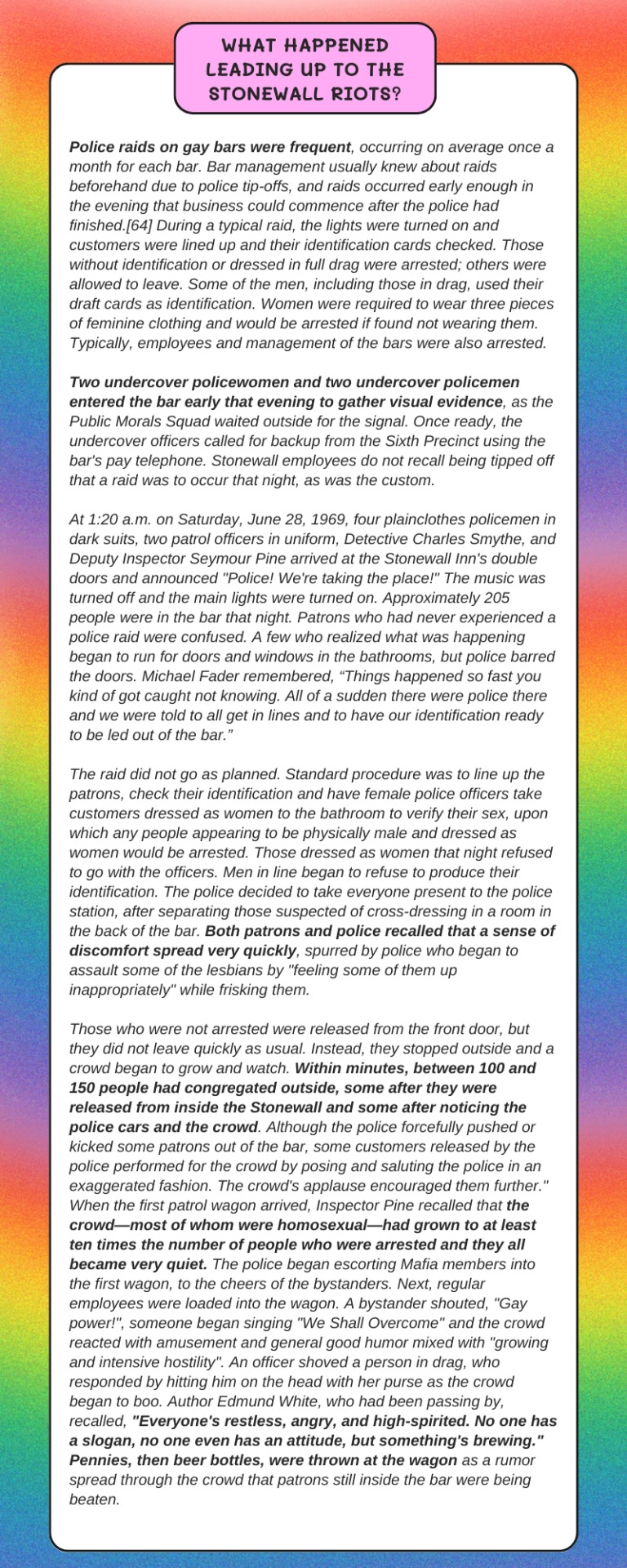
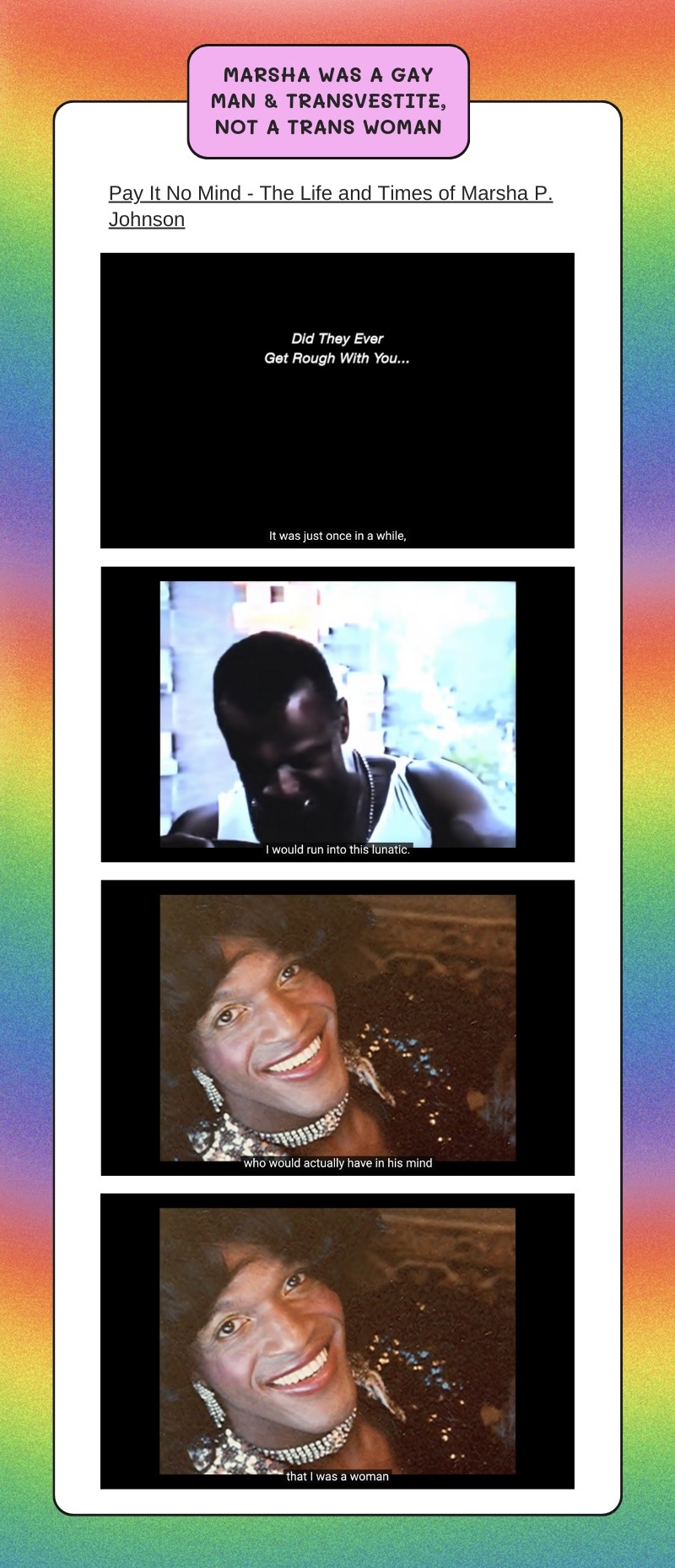
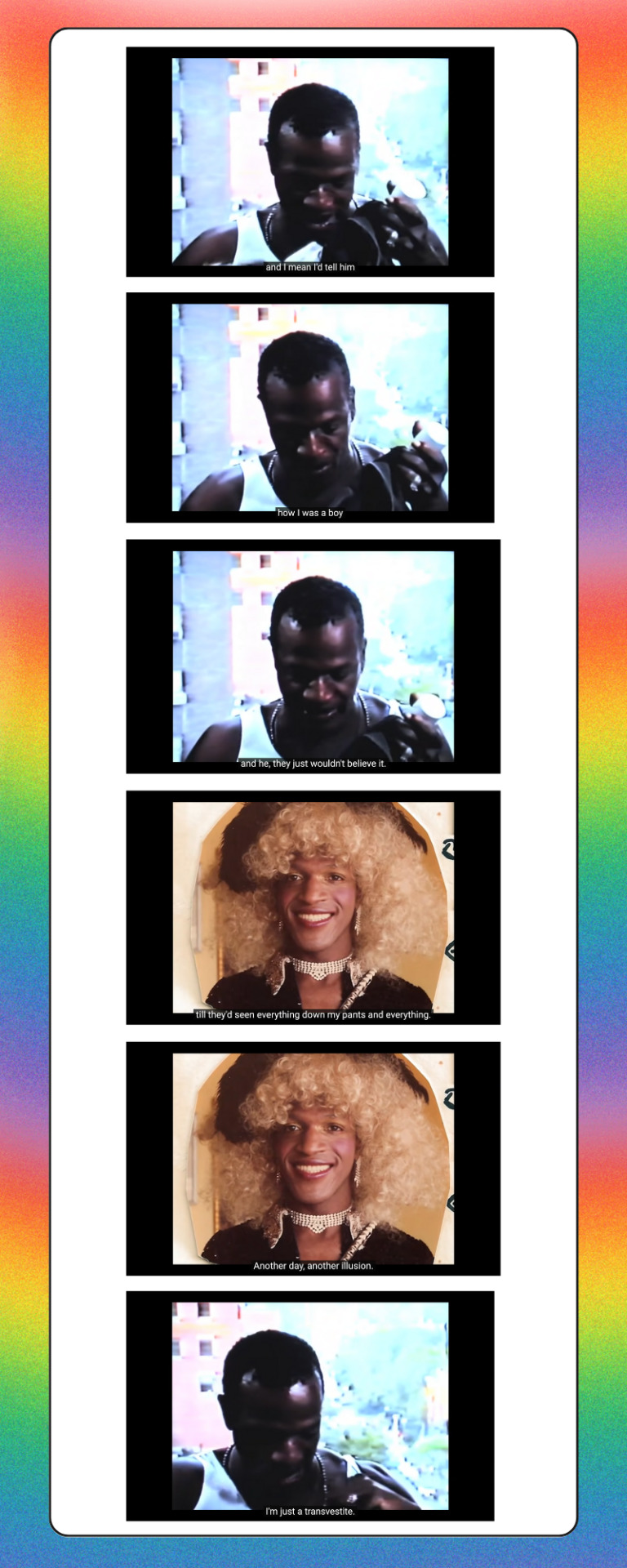



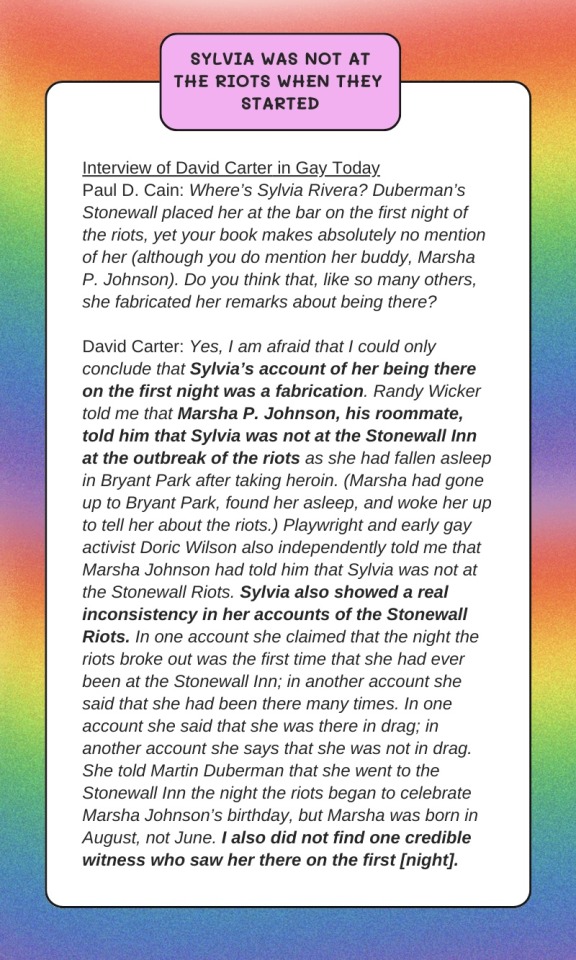

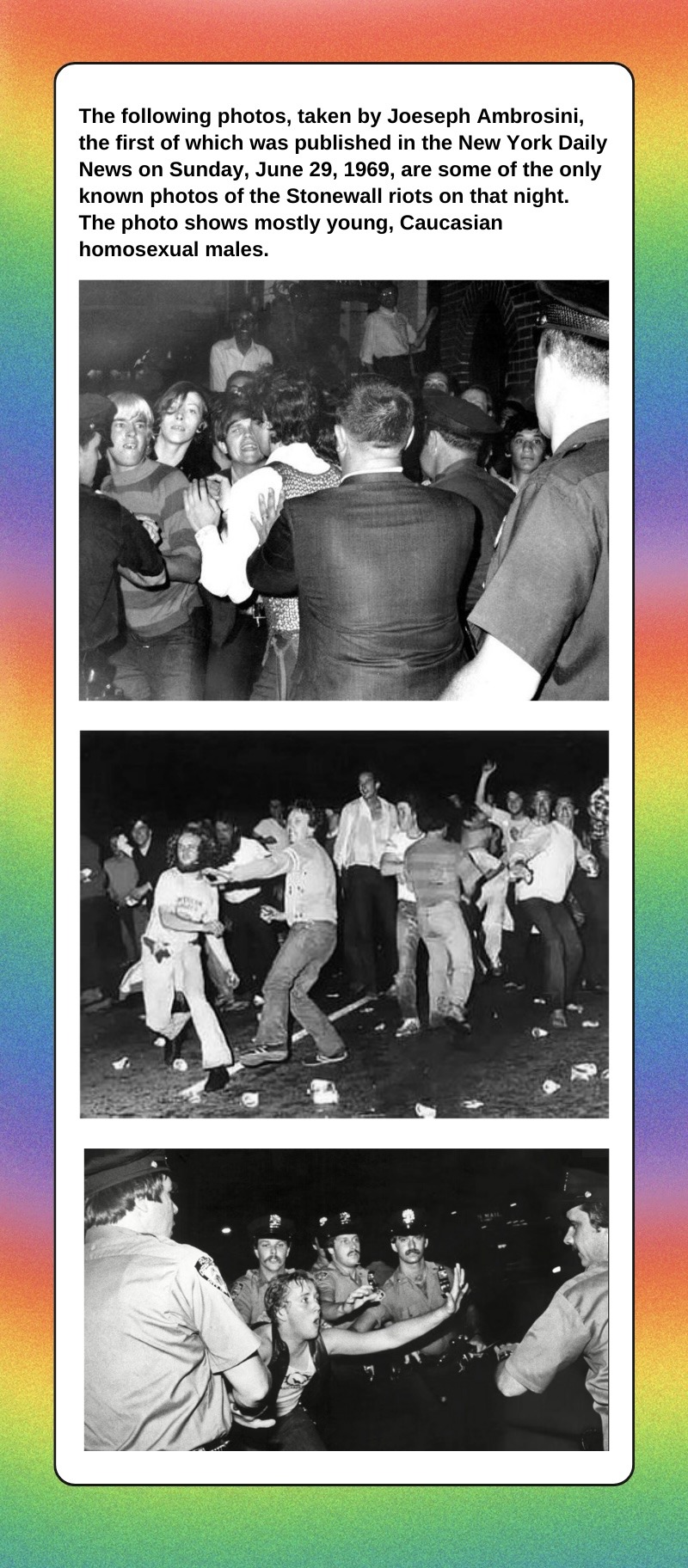
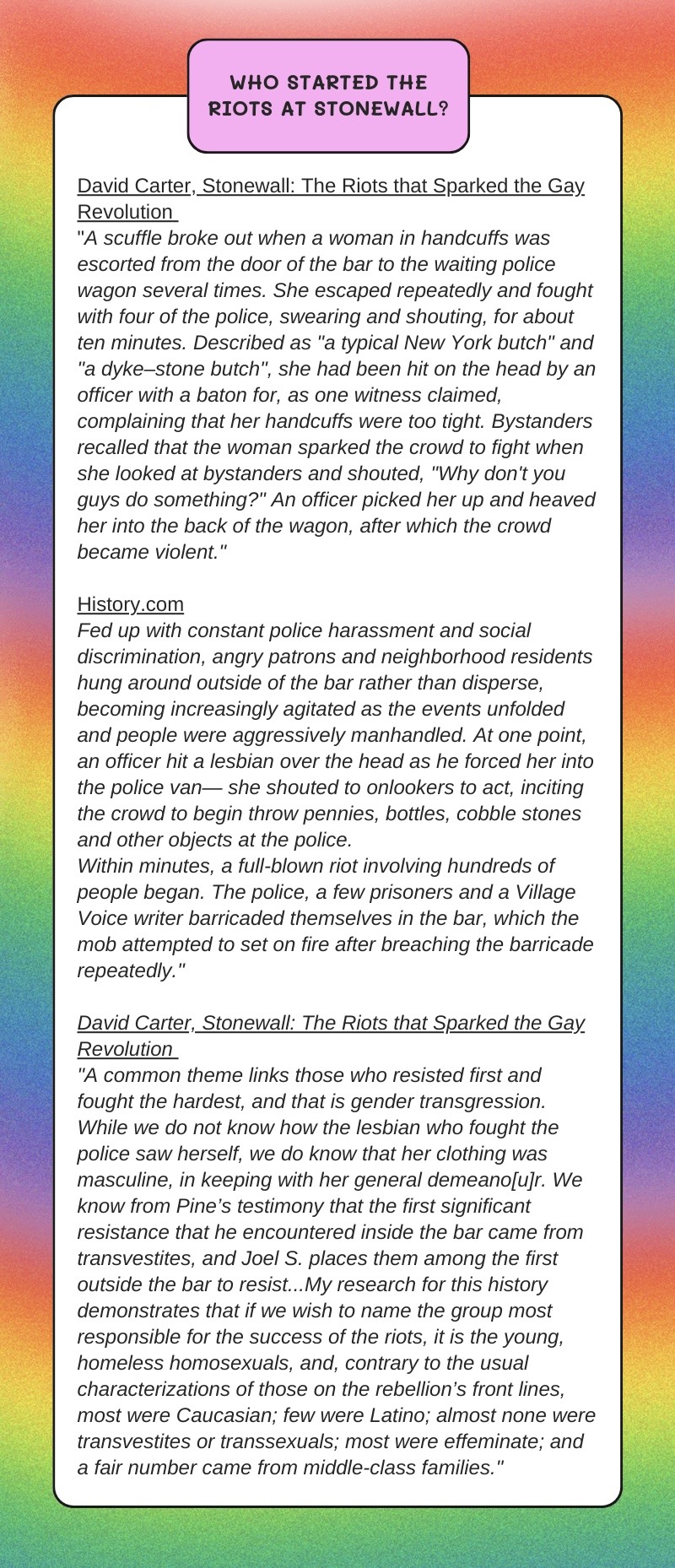
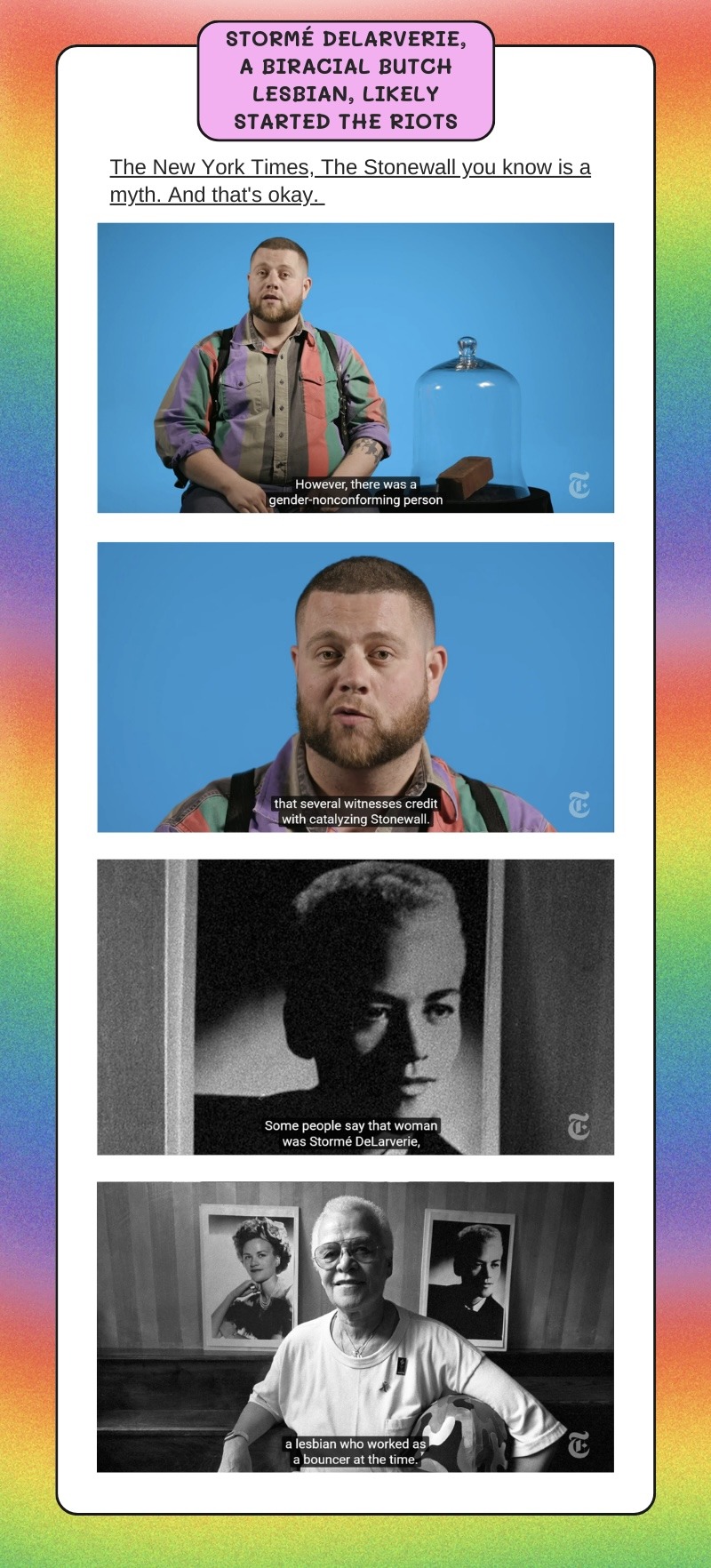
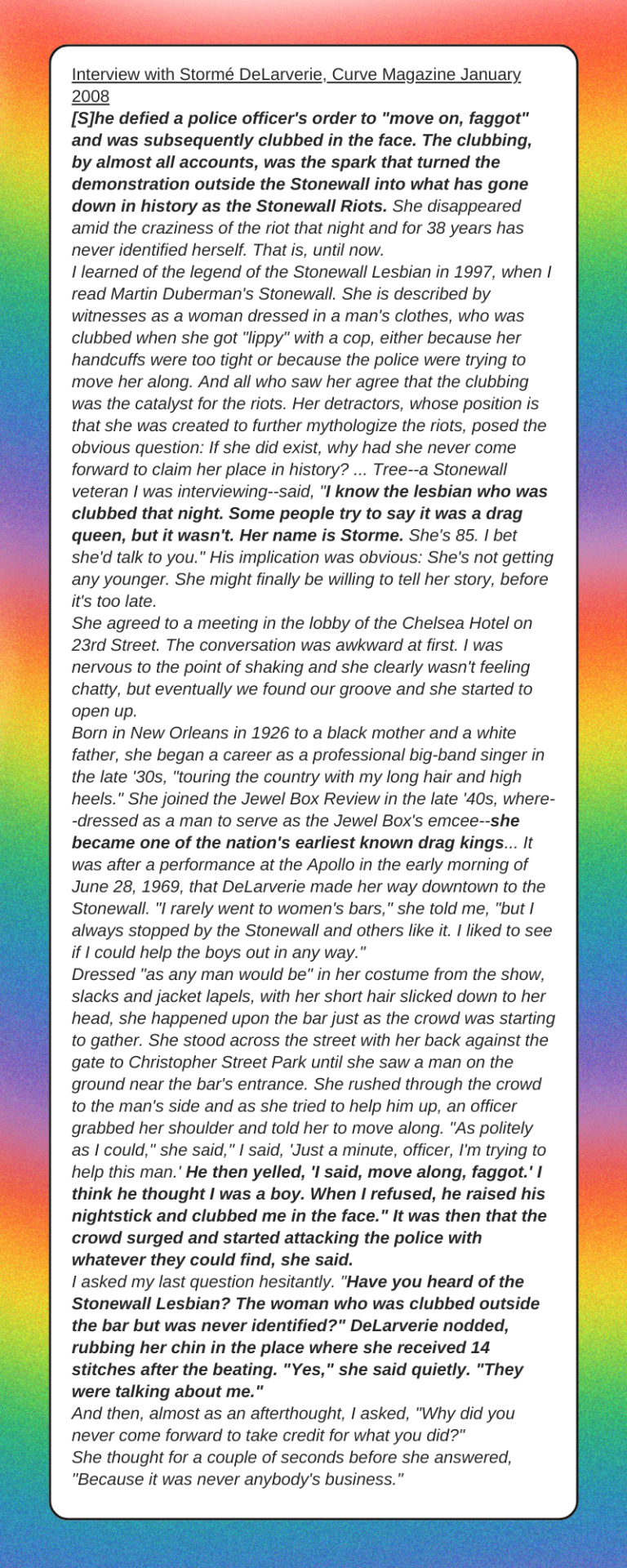
This was sitting unfinished for months but I got it together and completed it in time for pride.
Edit (6/12/23): I believe only the first Joseph Ambrosini photo was confirmed to be taken the first night of the Stonewall riots; I couldn't find sources that indicated if the other photos were taken on that same night or not.
1K notes
·
View notes
Text
as someone from a non-english speaking country (germany), „queer“ is not a slur to me - we do have equivalents for f-got and d-ke, but not queer.
germans have actually integrated a lot of english words into our language, so much so there is a word for it: „denglish“ from the german word for german which is „deutsch“ and the word „english“, similar to the usamerican „spanglish“. this really shows how much we culturally and politically rely on mostly the usa (perhaps because a big part of germany was under us control after the end of ww2) and how much debate and especially ideas we import from overseas.
„queer“ has been widely introduced only in the last few years with the rise of lgbtqia+ culture wars. we even have a „queerbeauftragter“ (queer delegate) who is called that and advises the government on all issues lgb and t and i guess intersex too. its „queer community“, „queer party“ etc plastered also on ads in the cities.
since we have a different history with the word, my main issue is not the slur aspect, but that this „umbrella term“ is on one hand associated with lgb and t, even though these groups (while having a considerable overlap) have different needs and demands, but on the other hand also used for different groups like nonbinary identified or intersex people and even kink and in the worst case pedophiles because people use it as „not heteronormative“, which paradoxically can include heterosexual people if they are trans, intersex, and like i said in extreme cases even kink or pedophilia.
as a bisexual woman myself i struggle with the fact that any space where i might meet other women like me is now „queer“. if you dont open these spaces up to everyone who identifies as some flavour of „queer“, you are an exclusionist, conservative, regressive. even the liberal government we have enforces this.
this trend of grouping in everyone who doesnt meet „societal standards“ into one group does not stop there. another (non-english) term that has been popularised is „flinta“ which stands for: frauen lesben intersex nichtbinär trans asexuell (women lesbians intersex nonbinary trans and asexual). at my old university we had two toilets: flinta and - men.
do they not realise that this is just enforcing male as the default and heterosexuality as the norm? do they not realise that for both political advocacy and practical use these terms are useless? that they do not describe a coherent group? that if you dont know and youre questioning your gender or sexuality or dont want to label it (which; youre probably either bisexual or just gender non conforming in some way), you can just say you’re questioning?
i have little in common with most „queer“ people and im sick that this term is supposed to describe the community im a part of (lgb), and people associate queer with lgb (and t), but i dont identify with it at all, and on an objective level its just useless because it allows all sorts of more or less legitimate, different groups to attach themselves to the fight for lgb rights.
#tbh I think the fact that queer was never used as a slur in this language is MORE reason not to use it#you (like people in general not op) wouldn't take other slurs from english and claim they're fine#´just generally think people cannot reclaim slurs that were never applied to them#but also yes absolutely I hate how nonspecific it is#it makes it a completely useless term
30 notes
·
View notes
Text
"Mother is the name for God on the lips and hearts of all children. Do you understand?"
-Eric Draven
157 notes
·
View notes
Text
I've revotalized a version of the (Radical) Feminist Sisterhood Flag originally made by Diana Russell!
OG flag by Diana

Dr Diana EH Russell, PhD, (November 1938 to July 2020) was a feminist writer and activist from Cape Town, South Africa. She was an anti-apartheidist, women's rights, and human rights activist.
She was a triple alumni who attended University of Cape Town, London School of Economics, and Harvard University.
She organized (along with other feminists) the first International Tribunal on Crimes Against Women, which was held in Brussels, Belgium.
She was anti-porn, anti-sex trade (or anti rape-economy), and properly defined femicide as the killing of human females because they are female. There is so much more about her to learn, I recommend dianarussell.com
Attention bilingual people:
Diana Russell really wanted her message of global sisterhood to be spread to as many feminists as possible. The uniting and collective organizing of women is how we secure more rights and begin to structurally reorder society towards female liberation. Diana's message unfortunately is only available in English so if you can reblog with a translation of the following, I'm sure Diana's spirit would much appreciate it.
Dear Visitors and Supporters, I'm convinced that the wide distribution of this feminist flag would help to bring attention to feminist actions, and to facilitate international feminist solidarity, thereby empowering our struggle to combat misogyny and sexism in all its oppressive and discriminatory forms. I regret that the words can only be in one language; but I have seen no good alternative to this limitation. I'm searching for a fabulous feminist organizer with the vision, energy, time and motivation to take on the important job of marketing this beautiful feminist flag. If you're interested in helping with this project, please contact me via my contact page. Thank you! —————— 2020 NOTE: Diana has passed away so she can no longer work on this project that was very important to her. But she would definitely want other feminists to take up the cause of creating a feminist flag, either using her flag design (please credit her if you use it), or another design. So please feel free to do so! Thank you! ❤️
In my contribution, I've created a high quality rendition of Diana's initial global sisterhood flag with essentially more vibrancy. I've also created a version that contains the radical feminist symbol I've created.
1.

This is definitely my favourite out of the set. Image ID on alt text.
2.

3.

4.

98 notes
·
View notes
Text
pride parade in my city today. I'm not going this year because being there just fills me with so much rage. It's just a bunch of drunk idiots in fetish gear and teenagers with flags and meme signs celebrating "their identity" while in so many countries people are still literally killed and imprisoned for being homosexual. No word or thought about them.
I'm glad we can have pride parades in my country but we should really be using this privilege to raise awareness for the many people who still suffer severely under homophobic societies and governments.
It's supposed to be a protest, not a party.
#pride month#pride 2024#and before anybody comes to me saying the memes and fetish gear actually help people in those countries#they do not#they make it worse actually
0 notes
Text
Does anyone have song/artist recommendations by female musicians but also not in English? I'm trying to make a playlist for my college radio show next week
180 notes
·
View notes
